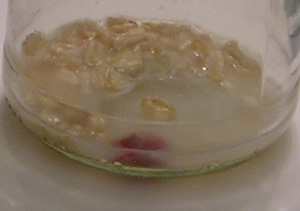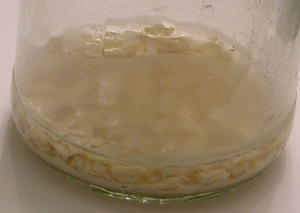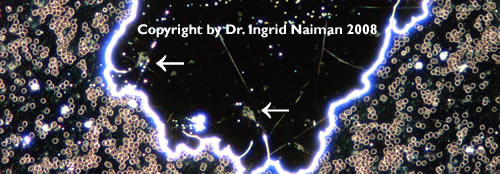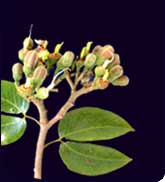I would like to discuss a tiny, very simple and perhaps simplistic experiment that a colleague and I did recently when he was passing through this area. We took two products that claim to be useful in mold remediation and my diffusing oil.

I had found some ghastly red mold in the water tray of my dehumidifier in the garage (not in an area of the unit that circulates anything back into the air, thank goodness). We divided this mold into three and put a bit, about one centimeter in diameter, in separate jars with lids. We added two drops of the fluids to each and watched for a little while. Then, I decided to give the mold something to eat, some cooked oatmeal. In a very short time, the jar with the diffuser blend of essential oils had no traces of the red. Nothing changed in the other two jars. We created a fourth jar with just oatmeal, no mold, just to see what kind of mold would grow without an "inoculation".
The experiment turned out to be interesting in a number of ways. The oatmeal, of course, gradually developed grayish-white "hairs" but these have not, in fact, grown in the other three jars, suggesting that the test substances all have some mold inhibiting power.
One of the substances tested was a probiotic. What is happening in this jar is that the oatmeal looks more and more creamy but there is no change in the red mold. It is not increasing in size nor vanishing. This is fascinating to me because the probiotic is obviously aiding "digestion" but it would apparently have limited power to destroy mold. It is however apparently competitive with the mold for nutrients and in this arena, it is a successful combatant for nutrition. I think the ramifications are worth consideration.
 The next jar contains a product made from citrus oil, but the scientific literature does not rate these oils nearly as highly as other essential oils where antifungal properties are concerned. They are useful mainly in food preservation, not decontamination. In the jar with this substance, the oatmeal is not growing fungus but the original red mold has not changed. I apologize for the photo quality; the pictures are not as clear as I would like them to be.
The next jar contains a product made from citrus oil, but the scientific literature does not rate these oils nearly as highly as other essential oils where antifungal properties are concerned. They are useful mainly in food preservation, not decontamination. In the jar with this substance, the oatmeal is not growing fungus but the original red mold has not changed. I apologize for the photo quality; the pictures are not as clear as I would like them to be.
In the jar with the diffusing oil blend, the oatmeal itself is nearly perfectly preserved and the red mold cannot be detected. In a few more days, I will put  the oatmeal under the microscope to see if the hyphal structures are also gone. In short, only the diffusing blend exhibited the properties one seeks in remediation and this oil would presumably make an effective solution for wiping down counters as well as inhibiting future growth. The fact that the other substances did not actually remove the mold suggests they are not effective in remediation even if they have mold-inhibiting properties.
the oatmeal under the microscope to see if the hyphal structures are also gone. In short, only the diffusing blend exhibited the properties one seeks in remediation and this oil would presumably make an effective solution for wiping down counters as well as inhibiting future growth. The fact that the other substances did not actually remove the mold suggests they are not effective in remediation even if they have mold-inhibiting properties.
Essential Oils
What does this mean? I just spent days and days and days reviewing the literature on essential oils to see if we can differentiate the various actions of the oils. We divide these into antifungal, mold-inhibiting, toxin-limiting, and perhaps also "consequence reducing" properties. An antifungal substance has the capacity to destroy yeast and/or mold and it generally achieves this through a chemical action that compromises the cellular structure of the fungus so that it can neither grow nor produce chemicals that are harmful, such as mycotoxins or hemolysins. As suggested in some previous posts, only a few oils are this potent, wild oregano topping the list, but several others are still excellent: cinnamon bark, clove bud, and often rosemary, thyme, and tea tree.
To be effective, the amount required must be neglible, way under 1% of the total solution. The oil must also disperse well in the carrier and water is generally a poor carrier since, as we know, oil and water usually do not blend well.
A mold-inhibitor prevents hyphal growth and sporulation. This is important also because inactive mold does not produce toxins or hemolysins though the mold would continue to be an irritant and some of the toxic properties would still exist if the inactive spores were ingested or inhaled. They would also still be capable of producing allergic reactions in people who are allergic to certain or all fungi.
In my opinion, the most dangerous aspects of mold are the two that are seldom discussed in medical literature: mycotoxins and hemolysins. Mycotoxins are acknowledged as a problem with a few of the better known molds such as stachybotrys and certain types of aspergillus, penicillium, and fusarium, but they are poorly understood even though very damaging to the central nervous system and liver and sometimes lungs and kidneys and other organs. Many mycotoxins are carcinogens so an essential oil that is neither antifungal nor mold-inhibiting but that reduces the danger of mycotoxins is not to be ignored. Basil is one such oil so while probably limited in application, it is not useless, and it would presumably be helpful for personal use post-exposure and during recovery periods.
Mold hemolysins are practically ignored by the medical profession, but, in my opinion, they are very dangerous. So, this might be a good time to introduce my newest web site: moldherbs.com. In the background picture, we see a darkfield image of a sample taken from peripheral blood of an elderly breast cancer patient from Switzerland. She had been battling breast cancer for twenty years and had lived in the same apartment during this entire time.
I do understand that my eyes are very adapted to seeing things that others might overlook or ignore, but in the "ugly" center of the blood sample, you see a dark area. For lack of a better term, I call this the "ghost town". When I see these in exams, I increase the magnfication to look for the cause. Generally, there is a toxin and in this instance, clearly, a hemolysin. If you look right at the bottom of the dark area, you see mold and there is another example of the same type on the left of the black area. What I first saw, in my own blood (in the image Damien put onto the TV monitor — a little PhotoShop, I confess, but honest PhotoShop work), is that the hemolysin mists off the top of the mold, always moving away from the mold itself (indicating that mold is probably not suicidal?)

There are vicious hemolysins and not so terrible ones. When people have infections of viable mold — as opposed to fragments — the mold is living inside the body. It is consuming the host and reproducing. Patients suffering from hemolysins are not just anemic but they are tired because of blood loss. So, anything that deactivates this process is potentially life saving and I honestly believe that horopito is at the top of this list. It is from New Zealand where the Maoris recognize it not merely as an antifungal but as an herb with very special mystical properties. I will perhaps ask one of my correspondents if she will kindly discuss this in more detail. In the meantime, this herb has been CO2 processed and encapsulated in vegetarian gelcaps by Kolorex, and I think it is a must for everyone suffering from blood loss and anemia due to mold infection.
Now, back to the Swiss patient. She had her apartment tested for mold and then remediated. She has been fine since this work was done. If you think of the ordeal a cancer patient goes through — in her case, a 20-year ordeal — you can readily appreciate that if correct diagnosis of the underlying problem had occurred much sooner, her life and the quality of her life would have been completely different.
Finally by way of discussion on this important topic, there are known consequences of mold exposure that are widely recognized yet still largely underestimated. These include allergies and loss of stamina. Jatoba is the penultimate herb for this problem, but, in my opinion, jatoba is not sufficiently antifungal to hold a position as a standalone treatment.
I would like to invite you to visit the new site. It is, I have to say, merely the shopping site for moldmisery.com, but by separating the products from the discussion, I hope I have made it easier for people to find what they need. There are only six pages, but I am sure I will be adding to the site as time goes on.
http://www.moldherbs.com
Many blessings,
Ingrid Naiman
6 June 2008
Copyright by Ingrid Naiman 2008
Subscribe
To be notified when there
are new posts, please subscribe by entering your email address
in the box below. You will receive an email asking
you to confirm your subscription; you can unsubscribe at
any time using the link at the end of any email you receive. Be
sure to put moldmisery@bioethika.com as an accepted email
correspondent or the emails will bounce. This is especially
important for AOL subscribers.



 The next jar contains a product made from citrus oil, but the scientific literature does not rate these oils nearly as highly as other essential oils where antifungal properties are concerned. They are useful mainly in food preservation, not decontamination. In the jar with this substance, the oatmeal is not growing fungus but the original red mold has not changed. I apologize for the photo quality; the pictures are not as clear as I would like them to be.
The next jar contains a product made from citrus oil, but the scientific literature does not rate these oils nearly as highly as other essential oils where antifungal properties are concerned. They are useful mainly in food preservation, not decontamination. In the jar with this substance, the oatmeal is not growing fungus but the original red mold has not changed. I apologize for the photo quality; the pictures are not as clear as I would like them to be. the oatmeal under the microscope to see if the hyphal structures are also gone. In short, only the diffusing blend exhibited the properties one seeks in remediation and this oil would presumably make an effective solution for wiping down counters as well as inhibiting future growth. The fact that the other substances did not actually remove the mold suggests they are not effective in remediation even if they have mold-inhibiting properties.
the oatmeal under the microscope to see if the hyphal structures are also gone. In short, only the diffusing blend exhibited the properties one seeks in remediation and this oil would presumably make an effective solution for wiping down counters as well as inhibiting future growth. The fact that the other substances did not actually remove the mold suggests they are not effective in remediation even if they have mold-inhibiting properties.